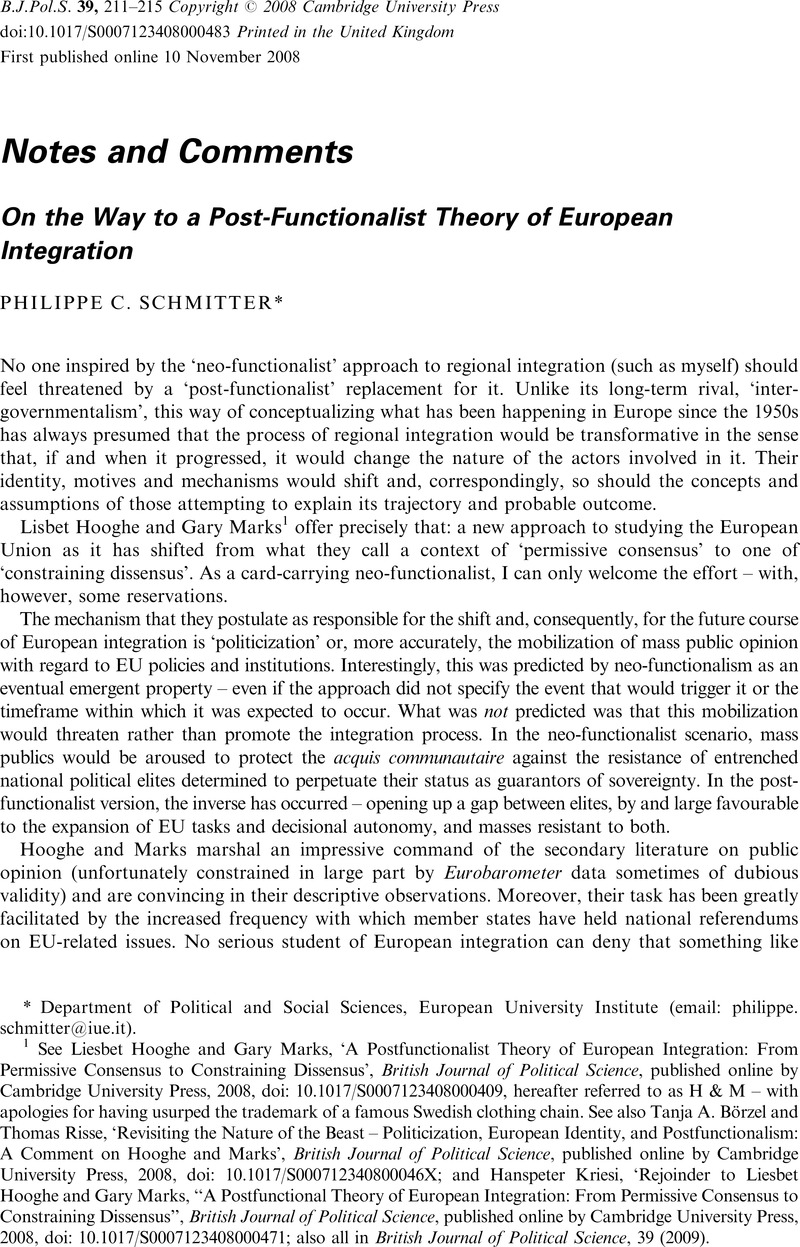Published online by Cambridge University Press: 01 January 2009

1 See Liesbet Hooghe and Gary Marks, ‘A Postfunctionalist Theory of European Integration: From Permissive Consensus to Constraining Dissensus’, British Journal of Political Science, published online by Cambridge University Press, 2008, doi: 10.1017/S0007123408000409, hereafter referred to as H & M – with apologies for having usurped the trademark of a famous Swedish clothing chain. See also Tanja A. Börzel and Thomas Risse, ‘Revisiting the Nature of the Beast – Politicization, European Identity, and Postfunctionalism: A Comment on Hooghe and Marks’, British Journal of Political Science, published online by Cambridge University Press, 2008, doi: 10.1017/S000712340800046X; and Hanspeter Kriesi, ‘Rejoinder to Liesbet Hooghe and Gary Marks, “A Postfunctional Theory of European Integration: From Permissive Consensus to Constraining Dissensus”, British Journal of Political Science, published online by Cambridge University Press, 2008, doi: 10.1017/S0007123408000471; also all in British Journal of Political Science, 39 (2009).
2 H & M, p. 18.
3 See Philippe C. Schmitter, ‘Neo-Neofunctionalism’, in A. Wiener and T. Diez, eds, European Integration Theory (Oxford: Oxford University Press, 2004), pp. 45–74.
4 Actually, according to old-fashioned neo-functionalism, there is a second ‘non-barking dog’ that I do not have the space to explicate. Here, the assumption was that the integration process would trigger a much more substantial flow of migration across national borders within Europe. Except for selected professionals (and many purchasers of second homes), there has been much less of this than expected. West Europeans have proved to be quite immobile. In the case of Southern Enlargement, membership in the European Union even led to a decline rather than an increase in transnational mobility. Eastern Enlargement, at least in the short run, has triggered much more substantial migratory flows – and this is a good thing in theory (if not in practice). These intra-European migrants were supposed to become important defenders of regional institutions (and, perhaps, identity).
5 I have explored this theme in ‘Parties are not what they once were’, in L. Diamond and R. Gunther, eds, Political Parties and Democracy (Baltimore, Md.: The Johns Hopkins University Press, 2001), pp. 67–89.
6 H & M make no reference at all to the subnational level. Since the phenomenon of relatively autonomous patterns of partisan cleavage at this level is relatively recent, it might be presumed that they would correspond more closely with what is happening at the European level. Certainly, the slogan of ‘The Europe of Regions’ seemed to promise such a re-alignment. Whatever the emergent reality, one might have expected a ‘multi-level governance’ perspective to at least speculate about its importance.
7 For a few suggestions of modest reforms that might do this, see Philippe C. Schmitter, How to Democratize the European Union – and Why Bother? (Boulder, Colo.: Rowman & Littlefield, 2000).
8 Ignorance prevents me from speculating about the potential contribution that might come from the subnational level – from the provinces, regioni, Länder, estados autonómicos, and so forth. My impression is that autonomy in local party organization has been on the increase, precisely because the traditional national level cleavages have declined in significance with regard to the issues involved at that level. Whether the ‘sub-’ could combine with the ‘supra-’ to redefine the lines of strategic partisan competition is anyone’s guess.